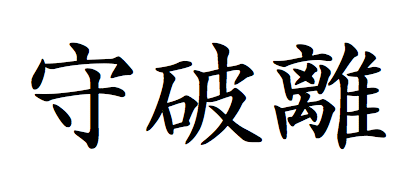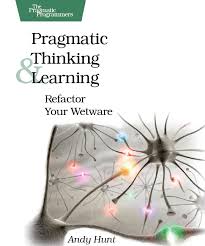Stuck at Shu
31 Aug 2017 . development practices . Comments #agile development
Recently I was fortunate to hear Alistair Cockburn’s keynote at the Heart of Agile 2017 in Pittsburgh. During his talk he discussed Shu-Ha-Ri and the path to mastery. It started me thinking about how many organizations I’ve seen stifle this mastery before it ever begins to take hold.
What is Shu-Ha-Ri?
Shuhari is a Japanese martial art concept, and describes the stages of learning to mastery. It is sometimes applied to other disciplines…
— Wikipedia (May 20, 2017)
You can read more about Shu-Ha-Ri on wikipedia. It has been discussed in the context of agile software development for several years thanks to Alistair Cockburn and others including Martin Fowler.

Applied to Agile
This is how I describe Shu-Ha-Ri as applied to a team learning Scrum.
Shu
Teams start out in Shu by following the Scrum Guide and agile consultants’ advice like recipes or formulas. They don’t understand the value of what they are doing yet, but they are optimistically following along the best they can.
Ha
When the team gets to the Ha state they are performing Scrum well. They now understand and have internalized the value in the practices. Furthermore, they understand how the practices support the larger agile principles and values. They have progressed beyond just following the Scrum Guide and beginner advice. Having branched out, they start learning about other methods like XP, Kanban, lean software development techniques, etc. They are recognizing that Scrum doesn’t always hold every answer for them and are beginning to apply other techniques outside of their initial teaching to their daily work.
Ri
When teams get to the Ri state they have fully internalized the agile values and have mastered the art of improvisation. They don’t follow a strict methodology, but adopt practices and methods that best meet their needs given the context of the problem and their team. They grow even further by creating their own practices or hybrid practices that best meet their needs.
a team "doing scrum" and reflecting, will soon "not be doing scrum" pic.twitter.com/0G3MHw1pbh
— John Cutler (@johncutlefish) June 28, 2017
The Dreyfus Model
A modern analogue to Shu-Ha-Ri is the Dreyfus Model of skill acquisition from the 1970s. It consists of five stages:
- Novice
- Advanced Beginner
- Competent
- Proficient
- Expert
You can learn more about the Dreyfus Model in Andy Hunt’s excellent book, Pragmatic Thinking & Learning.

A Problem with Agile Adoptions
Resetting Teams
I’ve encountered agile transformation consultants who encourage every team in a development organization to have identical practices. I don’t necessarily fault them for this advice, they are trying to accomplish a lot in a very short period of time. Further, the experience level of teams within organizations can vary significantly. The unfortunate result of this forces every team to follow strict formulas. I’ve heard one consultant say, “I know that some of you have been agile practitioners for a decade, but everyone here has to go back to Shu and follow these steps exactly.” That comment illustrated that the consultant didn’t understand what effect his request would have on the productivity and morale of the organization.
The Cost of Ri Teams Operating at Shu
An important discovery resulting from Dreyfus Maturity Model research is that if experts follow the same rules that they devised for novices, the experts performed at a novice level.1
Scrum “By-the-Books”
I often hear organizations say “We do Scrum by the books!” They position this as a positive trait of the organization. They are so advanced in their Scrum implementation that they follow these formulas exactly. I cringe when I hear this, because I’ve seen this translate to teams with morale problems stuck in the Shu state.
I find Scrum to be a valuable framework (although it wouldn’t be my first choice for development teams). If you read the Scrum Guide you will find that it is a prescriptive, but lightweight framework. Unfortunately, the “by-the-books” Scrum implementations I’ve seen added a layer of agile consultant practices on top of the Scrum Guide that teams were expected to strictly follow by their organizations.
Skipping to Ri
I understand that these organizations are sending a message that they didn’t skip straight to the Ri state. Doing Scrum “by-the-books” means that they haven’t invented their own practices that completely disregard agile principles and values. Unfortunately, this too is very common, given how desirable it has become to call an organization “agile.”
Although these organizations have thankfully not skipped the Shu and Ha states, they are not much better off being permanently stuck in the Shu state.
Shu-Ha-Ri Considered Harmful? NO, Shu without the Ha and the Ri considered Harmful https://t.co/e2pQHyrOBa
— Primitivo Cachero (@primicachero) June 21, 2017
Shu Scrum Masters
Great Scrum Masters can really help Scrum teams improve. Nevertheless, having worked on successful XP teams without them, I am not convinced they are required. The opposite can also be true, poor Scrum Masters can have dramatically negative affects on teams. I have seen well-meaning, but poorly prepared, Scrum Masters exacerbate this “by-the-books” problem because they too are beginners and still just following formulas.
To become a Certified Scrum Master you need to pay for and attend a two day course, pass a test that is nearly impossible to fail, and get your certification. While I know that the creators of Scrum considered this the beginning of your Scrum journey, too often it is the only formal training Scrum Masters ever receive.
Now we have people whose experience is limited to two days of classroom sessions with the word “Master” in their job title. Unwittingly, organizations rely on these people as experts and yet they have no more relevant experience than anyone else in the organization.
Codifying Beginner Formulas
Organizations often begin their “agile transformation” by getting Scrum training. Consultants come in for several weeks and teach the organization these beginner formulas. Their goal is to get everyone to the Shu state and on the same page. Unfortunately, it is common for companies just starting their agile journey to believe that keeping every team working the exact same way is an organizational optimization (I’ve written about this at length here).
The belief is that it’s easier for leadership to buy-in to this new way of working and manage at the portfolio-level when every team works the same way. No one asks what the company is surrendering for working this way. The sacrifice is substantial: team performance, team morale, and the ability for teams to improve themselves through retrospectives. They are sacrificing the same agile principles and values that they are trying to adopt.
This belief results in organizations codifying these beginner formulas before the team has a chance to master them. The codifying of these rules ensures that teams cannot deviate from them, halting all progress towards mastery as teams are permanently stuck in the Shu state.
Drive
The book Drive by Daniel Pink describes three components to intrinsic motivation: autonomy, mastery, and purpose. Preventing teams from getting to the Ha and Ri states destroys both autonomy and mastery on teams. It should come as no surprise that there are so many failed agile adoptions that leave a trail of frustrated people in its wake.
A Better Approach
Following agile consultants’ formulas exactly is a Shu state activity. You should absolutely not skip this step to avoid beginner teams that never understand the agile principles. However, don’t codify these practices, even if the Scrum Guide says it’s how teams should work. Let teams progress and master these practices, internalize the values, and then modify these practices to be unrecognizable to the ones in the Shu state. Otherwise, you are optimizing your organization for mediocrity and people will leave to achieve mastery elsewhere.
1: Cited in The Scope, Limits, and Training Implications of Three Models of Aircraft Pilot Emergency Response Behavior from Pragmatic Thinking & Learning by Andy Hunt